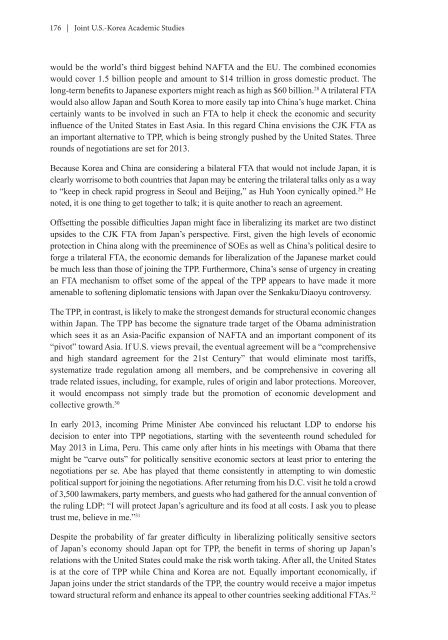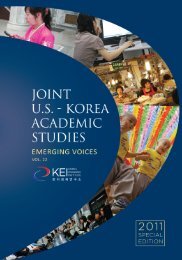the full publication PDF - Korea Economic Institute
the full publication PDF - Korea Economic Institute
the full publication PDF - Korea Economic Institute
You also want an ePaper? Increase the reach of your titles
YUMPU automatically turns print PDFs into web optimized ePapers that Google loves.
176 | Joint U.S.-<strong>Korea</strong> Academic Studies<br />
would be <strong>the</strong> world’s third biggest behind NAFTA and <strong>the</strong> EU. The combined economies<br />
would cover 1.5 billion people and amount to $14 trillion in gross domestic product. The<br />
long-term benefits to Japanese exporters might reach as high as $60 billion. 28 A trilateral FTA<br />
would also allow Japan and South <strong>Korea</strong> to more easily tap into China’s huge market. China<br />
certainly wants to be involved in such an FTA to help it check <strong>the</strong> economic and security<br />
influence of <strong>the</strong> United States in East Asia. In this regard China envisions <strong>the</strong> CJK FTA as<br />
an important alternative to TPP, which is being strongly pushed by <strong>the</strong> United States. Three<br />
rounds of negotiations are set for 2013.<br />
Because <strong>Korea</strong> and China are considering a bilateral FTA that would not include Japan, it is<br />
clearly worrisome to both countries that Japan may be entering <strong>the</strong> trilateral talks only as a way<br />
to “keep in check rapid progress in Seoul and Beijing,” as Huh Yoon cynically opined. 29 He<br />
noted, it is one thing to get toge<strong>the</strong>r to talk; it is quite ano<strong>the</strong>r to reach an agreement.<br />
Offsetting <strong>the</strong> possible difficulties Japan might face in liberalizing its market are two distinct<br />
upsides to <strong>the</strong> CJK FTA from Japan’s perspective. First, given <strong>the</strong> high levels of economic<br />
protection in China along with <strong>the</strong> preeminence of SOEs as well as China’s political desire to<br />
forge a trilateral FTA, <strong>the</strong> economic demands for liberalization of <strong>the</strong> Japanese market could<br />
be much less than those of joining <strong>the</strong> TPP. Fur<strong>the</strong>rmore, China’s sense of urgency in creating<br />
an FTA mechanism to offset some of <strong>the</strong> appeal of <strong>the</strong> TPP appears to have made it more<br />
amenable to softening diplomatic tensions with Japan over <strong>the</strong> Senkaku/Diaoyu controversy.<br />
The TPP, in contrast, is likely to make <strong>the</strong> strongest demands for structural economic changes<br />
within Japan. The TPP has become <strong>the</strong> signature trade target of <strong>the</strong> Obama administration<br />
which sees it as an Asia-Pacific expansion of NAFTA and an important component of its<br />
“pivot” toward Asia. If U.S. views prevail, <strong>the</strong> eventual agreement will be a “comprehensive<br />
and high standard agreement for <strong>the</strong> 21st Century” that would eliminate most tariffs,<br />
systematize trade regulation among all members, and be comprehensive in covering all<br />
trade related issues, including, for example, rules of origin and labor protections. Moreover,<br />
it would encompass not simply trade but <strong>the</strong> promotion of economic development and<br />
collective growth. 30<br />
In early 2013, incoming Prime Minister Abe convinced his reluctant LDP to endorse his<br />
decision to enter into TPP negotiations, starting with <strong>the</strong> seventeenth round scheduled for<br />
May 2013 in Lima, Peru. This came only after hints in his meetings with Obama that <strong>the</strong>re<br />
might be “carve outs” for politically sensitive economic sectors at least prior to entering <strong>the</strong><br />
negotiations per se. Abe has played that <strong>the</strong>me consistently in attempting to win domestic<br />
political support for joining <strong>the</strong> negotiations. After returning from his D.C. visit he told a crowd<br />
of 3,500 lawmakers, party members, and guests who had ga<strong>the</strong>red for <strong>the</strong> annual convention of<br />
<strong>the</strong> ruling LDP: “I will protect Japan’s agriculture and its food at all costs. I ask you to please<br />
trust me, believe in me.” 31<br />
Despite <strong>the</strong> probability of far greater difficulty in liberalizing politically sensitive sectors<br />
of Japan’s economy should Japan opt for TPP, <strong>the</strong> benefit in terms of shoring up Japan’s<br />
relations with <strong>the</strong> United States could make <strong>the</strong> risk worth taking. After all, <strong>the</strong> United States<br />
is at <strong>the</strong> core of TPP while China and <strong>Korea</strong> are not. Equally important economically, if<br />
Japan joins under <strong>the</strong> strict standards of <strong>the</strong> TPP, <strong>the</strong> country would receive a major impetus<br />
toward structural reform and enhance its appeal to o<strong>the</strong>r countries seeking additional FTAs. 32










